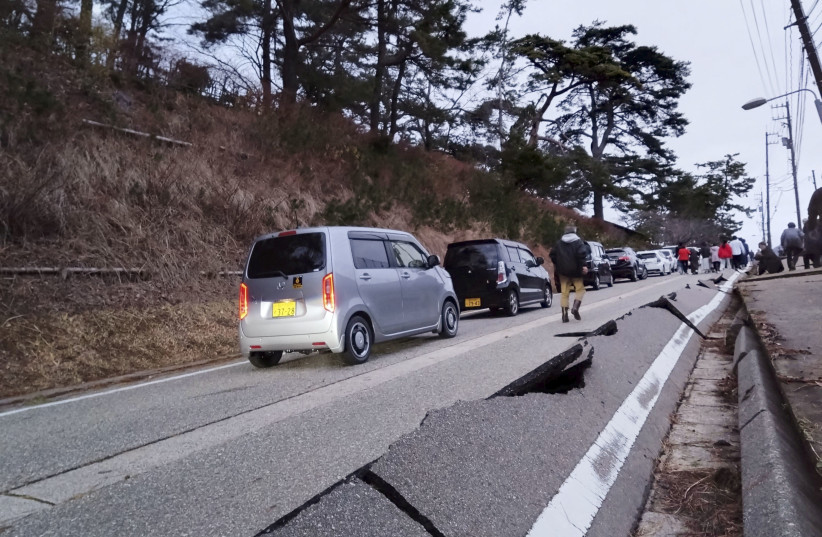A powerful earthquake and tsunami struck central Japan and its western coast on Monday, triggering warnings for residents to evacuate, knocking out power to thousands of homes, and disrupting flights and rail services to the affected region.
The quake, with a preliminary magnitude of 7.6, triggered waves of around 1 meter along parts of the Sea of Japan coast, with a larger wave expected, public broadcaster NHK reported.
The Japan Meteorological Agency has issued tsunami warnings for the coastal prefectures of Ishikawa, Niigata and Toyama. Russia also issued tsunami warnings in its far eastern cities of Vladivostok and Nakhodka.
A major tsunami warning means there is a possibility of waves of more than 3 meters (yards).
Russia also issued tsunami warnings in its far eastern cities of Vladivostok and Nakhodka.

Several houses have been destroyed and army units have been dispatched to help with rescue operations, top government spokesperson Hayashi Yoshimasa told reporters, adding that authorities were still assessing the extent of the damage.
Japan experiencing widespread power losses
More strong quakes in the area, where seismic activity has been simmering for more than three years, could occur over coming days, JMA official Toshihiro Shimoyama said.
In comments to the press shortly after the quake struck, Prime Minister Fumio Kishida also warned residents to prepare for more disasters.
"Residents need to stay on alert for further possible quakes and I urge people in areas where tsunamis are expected to evacuate as soon as possible," Kishida said.
"Run!" flashed a bright yellow warning aired on NHK advising residents in specific areas of the coast to immediately evacuate their homes.
Footage aired by NHK appeared to show buildings collapsing in a plume of dust in the coastal city of Suzu and residents in Kanazawa city cowering under tables as tremors shook their homes. The quake also jolted buildings in the capital, Tokyo, on the opposite coast.
More than 36,000 households had lost power in Ishikawa and Toyama prefectures, utilities provider Hokuriku Electric Power said.
High-speed rail services to Ishikawa have been suspended, while telecom operators Softbank and KDDI reported phone and internet service disruptions in Ishikawa and Niigata, according to their websites.
Japanese airline ANA turned back four planes headed to airports in Toyama and Ishikawa midair after the quake, while Japan Airlines canceled most of the flight services to Niigata and Ishikawa regions for the rest of the day, according to TV Asahi.
No irregularities at Japan's nuclear plants
Japan’s Nuclear Regulation Authority said no irregularities have been confirmed at nuclear power plants along the Sea of Japan, including five active reactors at Kansai Electric Power’s Ohi and Takahama plants in Fukui Prefecture.
Hokuriku's Shika plant in Ishikawa, which was located the closest to the quake’s epicenter, had already halted its two reactors before the quake for regular inspection and saw no impact from the quake, the agency said.
A huge earthquake and tsunami struck northeastern Japan on March 11, 2011, killing nearly 20,000 people, devastating towns, and triggering nuclear meltdowns in Fukushima.
Another quake, known as the Great Hanshin Earthquake, hit western Japan in 1995, killing more than 6,000 people, mainly in the city of Kobe.
Monday's quake struck during the Jan. 1 public holiday when millions of Japanese traditionally visit temples to mark the new year.
Residents forced to evacuate
In Kanazawa, a popular tourist destination in Ishikawa, images showed the remnants of a collapsed torii gate strewn at the entrance of a shrine as anxious worshippers looked on.
Kanazawa resident Ayako Daikai said she had evacuated to a nearby elementary school with her husband and two children soon after the earthquake hit.
"I also experienced the Great Hanshin Earthquake, so I thought it would be safest to evacuate," she told Reuters when contacted by telephone. The upper floors of the four-story school had filled with residents, she said.
"We haven't decided when to return home yet."
The jolt was also felt by tourists who had flocked to Japan's mountainous Nagano region for the start of the snow sports season.
Johnny Wu, a 50-year-old Taiwanese snowboarder, was waiting for a shuttle bus back to his hotel in the resort town of Hakuba when the quake hit, rattling windows and shaking snow of roofs and overhead electric wires.
"Everybody was panicked at that time. I’m a little bit better because, I come from Taiwan, so I've experienced a lot. But still, (I'm) still worried about (the quake) getting more serious," he said.
